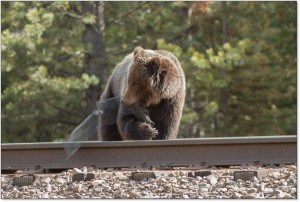
A joint research project between Parks Canada and Canadian Pacific Railway about reducing collisions between grizzly bears and trains could have implications for Jasper.
The five-year study tracked collared grizzly bears in Banff and Yoho National Parks to get a better understanding about why grizzly bears are using railway lines and how Parks Canada and CP Rail can reduce the risk of collisions between grizzly bears and trains.
The research project found that leaking grain cars, often blamed for wildlife mortality along the tracks, is not the only reason grizzly bears are attracted to railway lines.
“Our main conclusion is that we see grain is not the only attractant that brings bears and other animals to the rail and we think it may not be the most important attractant,” said Colleen Cassady St. Clair, the project leader from the University of Alberta.
“It’s a much more complex problem than anyone realized.”
According to her research, while grain was most often spilled in the west end of Banff National Park, bears and other wildlife died mostly in the east end of the park.
She said her research showed the noise of heavy trucks that use the Trans-Canada Highway nearby make it harder for bears to hear approaching trains. As a result bears walk along the winding sections of the track, often at night, and are startled or confused when suddenly confronted by an oncoming freight train.
According to St. Clair, bears and other animals often freeze when confronted by an oncoming train or they try to run in the opposite direction.
“We did some measurements of the auditory cues they get and we found that those cues can be quite misleading or obscured in some places by topography or surrounding noise,” said St. Clair. “They can’t hear trains coming or they can’t detect the direction accurately or they aren’t able to realize that the train is accelerating or decelerating, which also changes the amount of noise it produces.”
She said a lot of bears appear to be struck by trains in areas where there is human use suggesting bears are using railway tracks to avoid humans.
The report also found bears are attracted to railway tracks to travel more efficiently through the park, eat other animals killed on the tracks and to forage for plants such as buffalo berries and dandelions in the spring.
While her research focused on Banff, St. Clair said there are a lot of parallels with Jasper.
“You have the main line of a national railway that carries grain going right through the middle of the park, you have mountain topography, and there are curves on the railway, but you have very little grizzly bear mortality,” St. Clair said, about Jasper National Park.
According to St. Clair, 17 grizzlies have died in Banff in 17 years. She did not have data for Jasper.
“Grizzly bears crossing on railway tracks is not a common source of mortality in Jasper National Park,” wrote Steve Young, a communications officer for Parks Canada.
“We will however monitor the pilot project in Banff and Yoho National Parks to see if the targeted management actions can be adopted within Jasper National Park.”
According to St. Clair, Parks Canada has been conducting its own study in JNP about grain disposition, however it doesn’t seem to endanger bears in the same way as it does in Banff.
She speculated that it might be because the valley is much wider, the track is straighter and the fact that Jasper incinerates animals struck by trains and cars.
“Jasper doesn’t redistribute the carcasses of ungulates that are killed on the rail, it incinerates them,” said St. Clair, explaining that’s not the case in Banff.
She also speculated that the lack of fencing along Jasper’s highways, which provide a source of food from road kill, might play a role.
“The mitigation with the wildlife crossing structures (in Banff) has removed access to road kill for predators and scavengers,” said St. Clair. “I think that is a huge protein supplement.”
In Jasper, Canadian National Railway owns the railway line that runs through the park.
“The challenge faced in addressing wildlife mortality is exceedingly complex and requires significant study to determine the factors at play, locations where mitigation measures are best focused and also potential negative impacts of any measures taken,” wrote Kate Fenske, a media relations officer for CN.
According to her, grizzly bear mortality is rare and the company is more focused on reducing moose mortality in northern B.C. CN has also been addressing big horn sheep mortality in Jasper National Park since 2000 when fencing structures were installed in a high-risk area of Brule Tunnel near the east gate.
“CN will continue taking part in the ongoing discussions around wildlife mortality with railways, researchers, provincial staff and Parks Canada,” wrote Fenske, adding CN representatives attended the grizzly bear meeting in Banff last week with representatives from other railways to share their experience about mitigation measures.
To reduce the risk to grizzlies St. Clair said one possible solution includes implementing early warning signals near collision hot spots to warn animals about oncoming trains.
CP Rail and Parks Canada are currently testing a device with flashing lights and sounding alarms in four locations in Banff National Park.
Other solutions offered by Parks Canada and CP Rail include improving existing trails near railway tracks to provide bears with alternative travel routes, improve sightlines and using prescribed burns to enhance grizzly bear habitat elsewhere in the park.
Researchers are also testing fencing and electric mats to keep bears off the tracks, however more research is still needed. The electric mats could be used in locations where cattle guards aren’t fully effective or at lubrication stations along the tracks.
The joint initiative was launched in 2010, with $1 million invested by CP Rail. Research was also done in collaboration with the University of Alberta and the University of Calgary.
Paul Clarke
[email protected]
